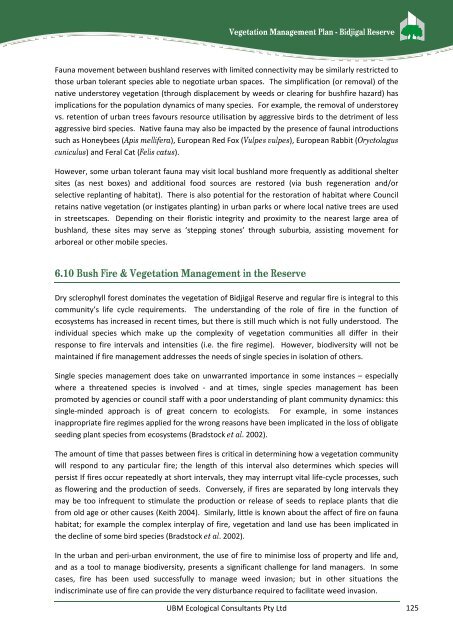VEGETATION MANAGEMENT PLAN for Bidjigal Reserve - Land
VEGETATION MANAGEMENT PLAN for Bidjigal Reserve - Land
VEGETATION MANAGEMENT PLAN for Bidjigal Reserve - Land
You also want an ePaper? Increase the reach of your titles
YUMPU automatically turns print PDFs into web optimized ePapers that Google loves.
Vegetation Management Plan - <strong>Bidjigal</strong> <strong>Reserve</strong>Fauna movement between bushland reserves with limited connectivity may be similarly restricted tothose urban tolerant species able to negotiate urban spaces. The simplification (or removal) of thenative understorey vegetation (through displacement by weeds or clearing <strong>for</strong> bushfire hazard) hasimplications <strong>for</strong> the population dynamics of many species. For example, the removal of understoreyvs. retention of urban trees favours resource utilisation by aggressive birds to the detriment of lessaggressive bird species. Native fauna may also be impacted by the presence of faunal introductionssuch as Honeybees (Apis mellifera), European Red Fox (Vulpes vulpes), European Rabbit (Oryctolaguscuniculus) and Feral Cat (Felis catus).However, some urban tolerant fauna may visit local bushland more frequently as additional sheltersites (as nest boxes) and additional food sources are restored (via bush regeneration and/orselective replanting of habitat). There is also potential <strong>for</strong> the restoration of habitat where Councilretains native vegetation (or instigates planting) in urban parks or where local native trees are usedin streetscapes. Depending on their floristic integrity and proximity to the nearest large area ofbushland, these sites may serve as ‘stepping stones’ through suburbia, assisting movement <strong>for</strong>arboreal or other mobile species.6.10 Bush Fire & Vegetation Management in the <strong>Reserve</strong>Dry sclerophyll <strong>for</strong>est dominates the vegetation of <strong>Bidjigal</strong> <strong>Reserve</strong> and regular fire is integral to thiscommunity’s life cycle requirements. The understanding of the role of fire in the function ofecosystems has increased in recent times, but there is still much which is not fully understood. Theindividual species which make up the complexity of vegetation communities all differ in theirresponse to fire intervals and intensities (i.e. the fire regime). However, biodiversity will not bemaintained if fire management addresses the needs of single species in isolation of others.Single species management does take on unwarranted importance in some instances – especiallywhere a threatened species is involved - and at times, single species management has beenpromoted by agencies or council staff with a poor understanding of plant community dynamics: thissingle-minded approach is of great concern to ecologists. For example, in some instancesinappropriate fire regimes applied <strong>for</strong> the wrong reasons have been implicated in the loss of obligateseeding plant species from ecosystems (Bradstock et al. 2002).The amount of time that passes between fires is critical in determining how a vegetation communitywill respond to any particular fire; the length of this interval also determines which species willpersist If fires occur repeatedly at short intervals, they may interrupt vital life-cycle processes, suchas flowering and the production of seeds. Conversely, if fires are separated by long intervals theymay be too infrequent to stimulate the production or release of seeds to replace plants that diefrom old age or other causes (Keith 2004). Similarly, little is known about the affect of fire on faunahabitat; <strong>for</strong> example the complex interplay of fire, vegetation and land use has been implicated inthe decline of some bird species (Bradstock et al. 2002).In the urban and peri-urban environment, the use of fire to minimise loss of property and life and,and as a tool to manage biodiversity, presents a significant challenge <strong>for</strong> land managers. In somecases, fire has been used successfully to manage weed invasion; but in other situations theindiscriminate use of fire can provide the very disturbance required to facilitate weed invasion.UBM Ecological Consultants Pty Ltd 125
















